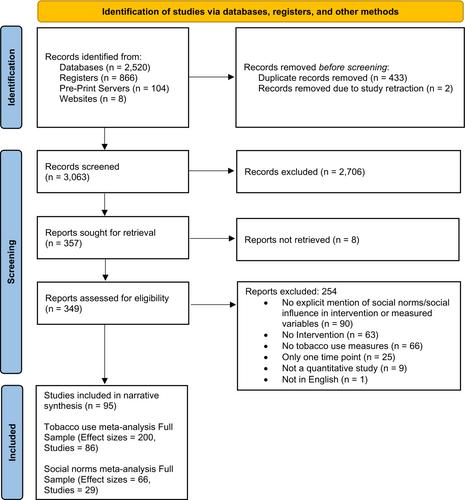Understanding the mechanisms of change in social norms around tobacco use: A systematic review and meta-analysis of interventions
Abstract
Background and Aims
Tobacco use spreads through social networks influencing social norms around tobacco use. However, the social norms scholarship is extremely diverse and occasionally conflicting, complicating efforts to understand how best to leverage social norms to reduce tobacco use. This study systematically reviewed and meta-analyzed this vast terrain by focusing on social norms measurement and mechanism, and intervention effectiveness and modality aimed at changing social norms around tobacco use and actual tobacco use.
Methods
We searched Scopus, PubMed, PsycInfo, Clinicaltrials.gov, ProQuest Dissertations, the Cochrane Trial Registry, as well as the websites of the Society for Research on Nicotine and Tobacco, the Open Science Framework, medrXiv and the Truth Initiative for experimental and quasi-experimental evaluation studies of interventions designed to shift tobacco use. We included studies written in English from inception to 30 May 2024. We only included studies which noted social norms or social influence as part of the intervention design or set of measured variables. We excluded studies with only one time point, without an intervention being evaluated and those not published in English. Study screening followed the PRISMA 2020 guidelines, and was conducted by at least two independent reviewers who resolved discrepancies through discussion and consensus. All included studies were analyzed in a narrative synthesis, and those providing sufficient statistics for tobacco and social norms outcomes were included in meta-analyses, which were performed separately for tobacco outcomes and social norms outcomes. Study outcomes were transformed into a standardized mean difference (Hedges' g) and several meta-regressions were fit to explore sources of heterogeneity using a robust variance estimation specification to handle effect size dependency.
Results
A total of 95 studies met inclusion criteria for the narrative synthesis, 200 effect sizes from 86 studies were included in the tobacco outcomes meta-analysis, and 66 effect sizes from 29 studies were included in the social norms outcomes meta-analysis. Nearly 90% of included studies were conducted in high-income settings, with the remainder conducted in middle-income settings. No studies were conducted in Latin America or on the African continent. Social norms change interventions had a statistically significant effect on reducing tobacco use and pro-tobacco social normative perceptions [g = 0.233, 95% confidence interval (CI) = 0.166, 0.301, P < 0.001 and g = 0.292, 95% CI = 0.090, 0.494, P = 0.007, respectively]. Interventions were commonly conducted among schoolchildren in classrooms through multicomponent education sessions, often coupled with regular ‘booster' sessions over time. Among adult populations, motivational interviewing and other counselling approaches were used in some cases, and few interventions leveraged digital technologies to change social norms.
Conclusions
Social norms change interventions appear to be effective for reducing tobacco use and pro-tobacco social normative perceptions. In particular, leveraging role models appears to be the most effective social norms change mechanisms for tobacco control.


 求助内容:
求助内容: 应助结果提醒方式:
应助结果提醒方式:


